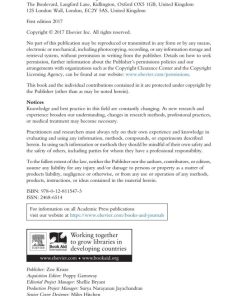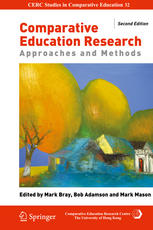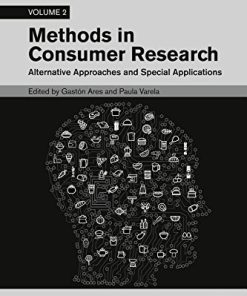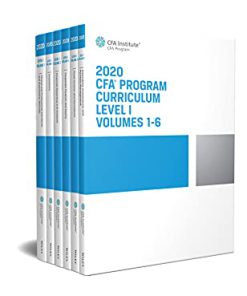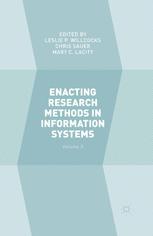Methods in Consumer Research Volume 1 New Approaches to Classic Methods 1st Edition by Woodhead Publishing ISBN 0081012586 9780081012581
$50.00 Original price was: $50.00.$25.00Current price is: $25.00.
Methods in Consumer Research Volume 1 New Approaches to Classic Methods 1st Edition by Woodhead Publishing – Ebook PDF Instant Download/Delivery: 0081012586, 9780081012581
Full download Methods in Consumer Research Volume 1 New Approaches to Classic Methods 1st Edition after payment
Product details:
ISBN 10: 0081012586
ISBN 13: 9780081012581
Author: Woodhead Publishing
Methods for Consumer Research, Volume One: New Approaches to Classic Methods brings together world leading experts in global consumer research who provide a fully comprehensive state-of-the-art coverage of advances in the classical methods of consumer science. The book touches on the latest developments in qualitative techniques, including coverage of both focus groups and social media, while also focusing on liking, a fundamental principle of consumer science, consumer segmentation, and the influence of extrinsic product characteristics, such as packaging and presentation on consumer liking.
In conjunction with the second volume, which covers alternative approaches and special applications, this book is an invaluable reference for academics working in the fields of in-sensory and consumer science, psychology, marketing and nutrition. And, with examples of the methodology being applied throughout, it serves as a practical guide to research and development managers in both food and non-food companies.
- Presents a fully comprehensive coverage of the latest developments in the classical methodologies of consumer research
- Provides examples of successful application of the methodologies presented
- Includes focus groups and social media discussions
- Encompasses consumer segmentation, with a focus on psychographics and genetics
Methods in Consumer Research Volume 1 New Approaches to Classic Methods 1st Table of contents:
Part I. Introduction
Chapter 1. Recent Advances in Consumer Science
1. Consumer Science: A Historical Perspective
2. Key Advancements in Sensory and Consumer Science
3. The Future: Remaining Challenges
4. The Book
Chapter 2. Complexity of Consumer Perception: Thoughts on Pre–Product Launch Research
1. Historical Perspective
2. Fallacies of Consumer Research
3. Novel Elements in Current Research
4. A Situational Approach
5. Integration of Different Factors in Different Situations
6. Examples of Situational Analysis
7. Current Practice: Collative Properties
8. Suggested Protocol for the Market Launch Testing of Intended Long-Life Products
9. Data Analysis and Interpretation
10. General Conclusion
Part II. Qualitative Techniques
Chapter 3. New Approaches to Focus Groups
1. Origin, History, and Definition
2. Making a Focus Group: General Recommendations
3. Uses of Focus Groups
4. New Approaches to Focus Groups
5. Conclusion and Final Remarks
Chapter 4. Projective Techniques
1. Introduction
2. Historic Evolution
3. Classification of Projective Techniques
4. Association Techniques
5. Construction Techniques
6. Completion Techniques
7. Expressive Techniques
8. Data Analysis
9. Future Trends and Conclusion
Chapter 5. Using Ethnography in Consumer Research
1. Introduction
2. How to Do Ethnography?
3. Ethnography in Industries
4. Case Study: Understanding Food and Beverage Habits in Peru
5. New Trends
6. Strengths and Weaknesses
Chapter 6. Application of Social Media for Consumer Research
1. Introduction
2. Approaches to Social Media Research
3. Conducting Social Media Research
4. Practical Applications of Social Media Research
5. Legal and Ethical Considerations
6. Strengths and Limitations
7. Conclusion
Part III. Liking and Beyond
Chapter 7. Product Performance Optimization
1. Introduction
2. Optimization Based on Sensory Attributes and Liking
3. Product Optimization “Beyond Liking”
4. Conclusion
Chapter 8. Consumer-Based Methodologies for Sensory Characterization
1. Introduction
2. Methodologies for Consumer-Based Sensory Characterization
3. Recommendations for the Use of Consumer Panels for Sensory Characterization and Remaining Challenges
4. Conclusion
Chapter 9. Dynamics of Consumer Perception
1. Measuring the Dynamics of Consumer Perception
2. Characterization of Products According to Sensory Attributes
3. Characterization of Products According to Emotional Response
4. Characterization of Products According to Hedonic Response
5. Opportunities for Linking Dynamic Data to Other Data
6. Data Analysis
7. Conclusion
Chapter 10. Affect-Based Discrimination Methods
1. Introduction
2. The Rejection Threshold
3. The Authenticity Test
4. Conclusions
Chapter 11. Emotional Responses to Products
1. Introduction: Why Measure Emotional Responses to Products
2. What Emotions Are We Measuring?
3. Measuring Emotional Responses to Products
4. Methodological Issues in Measuring Emotional Responses to Products Using Questionnaires
5. Case Study: New Product Development in Delicate Laundry Detergents. The Importance of Measuring Expectations
6. Future Trends
7. Sources of Further Information and Advice
Chapter 12. Recent Developments in Conceptual Profiling
1. The Etiology of New Product Failure
2. The Fundamental Nature of Conceptual Associations in Relation to Emotion
3. Conceptual Profiling Methodology
4. Conceptual Profiling: Examples and Case Studies
5. Predicting Emotional Outcomes
6. Overview
Chapter 13. Methodological Challenges of Research in Nudging
1. Introduction
2. Defining Nudging Research
3. Methodological Considerations and Directions for Future Research
Part IV. Consumer Segmentation
Chapter 14. Statistical Approaches to Consumer Segmentation
1. Introduction
2. Clustering Strategies
3. What Is Similarity?
4. Hierarchical Clustering
5. Criterion-Based Methods/Partition-Based Methods
6. Interpretation-Based Segmentation
7. Semisupervised Clustering
8. Comparison of Clustering Strategies
9. Cluster Validation
10. Three-Way Clustering
11. Steps in Cluster Analysis and Recommendations
12. Future Developments in Consumer Segmentation: Big Data
Chapter 15. Including Context in Consumer Segmentation: A Literature Overview Shows the What, Why, and How
1. Introduction
2. Why? The Relevance of Including Context in Consumer Segmentation
3. Practical Aspects
4. Overview of Current Knowledge: Selection of Variables to Include Context
5. Overview of Current Knowledge: What Has Already Been Done?
6. How to Include Context in Consumer Segmentation
7. Case Study
8. Conclusion
Chapter 16. Oral Processing: Implications for Consumer Choice and Preferences
1. Introduction
2. Mastication
3. Saliva
4. Receptors and Perception
5. Swallowing
6. Conclusion
Chapter 17. Consumer Segmentation Based on Genetic Variation in Taste and Smell
1. Introduction to Genetic Differences in Taste and Smell
2. Human Chemosensory Receptors
3. Methodology in Genotyping
4. Genetic Variation in the Food Perception Context
5. Summary and Conclusion
Part V. Influence of Extrinsic Product Characteristics
Chapter 18. Expectations: Blind/Informed Testing
1. Introduction
2. The Theory Behind Expectations
3. Considerations on How to Plan Studies to Investigate the Disconfirmation of Expectations That Comprise Expected, Blind, and Actual (Informed) Measurements
4. Implementing a Study Focusing on Expected/Blind/Informed Measurements
5. Practical Applications of Expected, Blind, and Actual (Informed) Measurements
Chapter 19. Conjoint Analysis in Sensory and Consumer Science: Principles, Applications, and Future Perspectives
1. Introduction
2. Historical and Conceptual Background
3. Conjoint Analysis Methodology: Basic Principles and Advances
4. Conjoint Analysis Methodology in Practice
5. Case Study: Identifying the Drivers of Consumers’ Purchase Intent for Iced Coffee
6. Limitations, Fallacies, and Recommendations
7. Current Trends in the Literature
8. Perspectives in Sensory and Consumer Science
9. Conclusion
Chapter 20. Credence
1. Introduction
2. The Concept of Quality
3. Credence and Its Role in Consumer Choice and Liking of Food
4. Credence Categories
5. Consumers’ Experienced Quality
6. Consumer Choice
7. Why Study the Effect of Credence on Consumer Liking?
8. The Role of Values, Beliefs, and Attitudes in Consumers’ Choice and Experiences
9. Assessing the Effects of Credence on Consumer Behavior
10. Methods
11. Example: Credence and Liking of Tomatoes
12. Conclusion
Chapter 21. Information Display Matrix
1. Introduction
2. Design of the Information Display Matrix
3. Theoretical Aspects of Decision-Making
4. Historical Development and Possible Applications
5. Analysis of Consumer Preferences
6. Analysis of Information Search Behavior
7. Comparison With Other Methods
8. Strengths and Weaknesses
9. Case Study: Food, More Than Organic?
10. Conclusions
Chapter 22. Experimental Economics to Evaluate Consumer Preferences
1. Introduction
2. Experimental Economics Methods to Analyze Consumer Preferences for Food Products
3. The Rationale for Using Experimental Economics to Analyze Consumer Preferences
4. Experimental Auctions
5. Multiple Price List Format
6. Differences Between Auctions and Hedonic Measurements
7. Data Analysis
8. New Developments and Future Research Avenues
People also search for Methods in Consumer Research Volume 1 New Approaches to Classic Methods 1st:
methods in consumer research
methods in consumer research volume 1
methods in consumer research volume 2
statistical methods in food and consumer research
handbook of research methods in consumer psychology
Tags:
Woodhead Publishing,Methods,Consumer Researchh,New Approaches,Classic Methods
You may also like…
Politics & Philosophy - Social Sciences
Biology and other natural sciences - Plants: Agriculture and Forestry
Business & Economics - Investing
CFA 2020 Level 1 Volume 1 Ethics and Quantitative Methods Various
Religion & Spirituality - Religious Studies
Computers - Applications & Software
Enacting Research Methods in Information Systems: Volume 1 1st Edition Leslie P. Willcocks
Computers - Applications & Software
Enacting Research Methods in Information Systems: Volume 3 1st Edition Leslie P. Willcocks





